At the end of January, the first Class 50 - D400/50050 Fearless - returned to Network Rail’s metals with a test run from Washwood Heath to Nuneaton. It was the first time in more than 15 years that it has operated on the national network under its own power.
Purchased by engineer Neil Boden in January 2015, the locomotive has undergone an extensive restoration at his Washwood Heath workshops, allowing it to join Boden’s two other main line registered Class 50s, 50007 Hercules and 50017 Royal Oak operating on the main line.
Just over 25 years ago, RAIL played an active part in persuading BR’s Network SouthEast (NSE) sector management to restore the locomotive ‘50’ into a version of its original BR blue livery, as applied when the locomotive was first rolled out of Vulcan Foundry’s workshops in Newton-le-Willows in June 1967.
The English Electric Type 4s (which became Class 50 under the British Rail TOPS renumbering scheme) were designed as mixed-traffic locomotives and the 50-strong fleet initially saw use on passenger and freight services on the West Coast Main Line (WCML) before being transferred to the West of England in the early 1970s as the electrification of the WCML progressed.
A complicated design, they were initially unpopular with crews and gained a reputation for poor reliability. However, refurbishment of the locomotives at Doncaster Works in the early 1980s removed a number of obsolete components and the refurbished locomotives quickly gained a reputation for improved reliability and their popularity amongst enthusiasts increased significantly.
Whilst they were powerful locomotives capable of maintaining 100mph running speeds, they were expensive to repair and susceptible to failure of major components such as main generators and electric train heating equipment. The first Class 50 to be withdrawn, 50011 Centurion, was taken out of service in February 1987 and over the next few months several others fell by the wayside.
By the middle of 1990, their use was concentrated on passenger services on NSE’s Waterloo to Exeter route with a number of them in departmental use.
The Class 50 fleet was in rapid decline and as the rundown accelerated so did the interest in them from enthusiasts. In the days before the internet, RAIL’s fortnightly publication schedule meant the magazine became essential reading for anyone interested in the latest news on the ‘50s’. The magazine even launched a pre-recorded phone line for those enthusiasts who couldn’t wait to find out the latest information in the magazine each fortnight.
Knowing the interest in the Class 50s, an approach was made to NSE’s charismatic director Chris Green in autumn 1990 to suggest that 50050 Fearless should be restored to original BR blue livery for its final few months in service. However, 50050 had suffered from a main generator failure in late summer 1990 and had been placed on decision at Plymouth Laira depot, with repairs or withdrawal the two options. Dumped out of use at Laira, had it not been for the suggestion of repainting the locomotive, it is highly likely it would have joined the growing list of withdrawn ‘50s’ sent for scrapping.
The Area Fleet Manager at Laira was Geoff Hudson, who was well aware of the popularity of the ‘50s’ on his books. He was also sympathetic to the idea of returning 50050 to as-near original condition as D400 once again. Green and Hudson backed returning the locomotive to service and agreed to fund the necessary repairs to allow it to be brought back into use. It was also agreed that 50050 could be repainted into original BR blue on condition that the costs of the repaint - estimated to be in the region of £2,500 - were met through sponsorship by RAIL.
During the refurbishment of the locomotives at Doncaster Works, several modifications had been carried out to the ‘50s’ which had changed their appearance from how they originally looked. Obsolete items such as the route indicator blinds and sanding ports had been plated over and these would not be reinstated as part of the backdating in order to keep costs down.
The news that D400 could be restored to BR blue was announced in RAIL 132. The story confirmed that Green had authorised the necessary repairs to the locomotive and agreed to the repaint. The cost of the repaint would be met by donations from RAIL readers, with RAIL’s publisher at the time, EMAP, agreeing to match each donation pound for pound. It also confirmed that work was scheduled to be completed in December 1990, although this target proved to be somewhat optimistic.
The idea quickly caught the attention of RAIL’s readers and the response to the appeal was almost instant with over £500 pledged within the first week after issue 132 had been published.
Over the following months, donations continued to be received towards the appeal and with £1,500 donated by readers and EMAP matching these donations. All in all, £3,000 was raised to fund the exhibition finish repaint to be applied to the rejuvenated D400.
Work on the locomotive progressed throughout late-1990 and early-1991, but completion of the locomotive was delayed due to the demands placed on maintenance staff at Laira keeping the other serviceable Class 50s in traffic. However, in late February, bodywork repairs and preparations for its repaint began. A month later the locomotive was completed and ready to be launched back into service.
It was announced that D400 would return to use on the Waterloo to Exeter route on April 6 1991. Its first revenue-earning service in its new guise was the 0945 Plymouth to Waterloo via Southampton, returning to the South West on the 1715 Waterloo to Exeter later in the day. Such was the interest in D400 that hundreds of people lined the route to catch a glimpse of the locomotive and many enthusiasts also travelled on services hauled by it.
RAIL reader and D400 appeal contributor Geoff Williams from Westbury was chosen to present the cheque for £3,000 to Peter Field, the network director for the South West and a short presentation took place at Waterloo during D400’s first day back in service. After the presentation Williams was invited to travel in the cab as far as Woking.
Following its return to service, it joined the ranks of ‘50s’ working for NSE on the Waterloo Exeter route but was plagued with a series of failures caused by engine problems from its new power unit. On August 21, the power unit completely failed and a replacement was required. With the rundown of the Class now reaching an advanced stage any other Class 50 would undoubtedly have been withdrawn, but Laira arranged for recently-withdrawn 50048 Dauntless to donate its power unit to allow D400 to return to use.
By 1992, the ranks of the operational Class 50s was down to single figures. With the ‘50s’ removed from daily service on the Waterloo-Exeter services in May 1992, NSE decided it would retain three operational Class 50s at Laira for working a programme of railtours for an indefinite period - 50007 Sir Edward Elgar, 50033 Glorious and D400. All three locomotives received repaints for their new roles, with D400 retaining BR blue, 50007 receiving another coat of its unique GWR 150th anniversary green livery and 50033 received a new coat of revised NSE colours.
Throughout 1992 and 1993 the three ‘50s’ made regular appearances at the head of various tours and special workings, alongside open day appearances across the BR network. To protect them from possible damage, the ‘50s’ were given restricted top speeds and for most tours at least two of the three ‘50s’ were used to provide some backup in the event of failure.
Towards the end of 1993 it was announced that the three ‘50s’ would be withdrawn at the end of March 1994 after working a series of farewell tours. It was also announced that 50033 was being claimed for the National Collection and would be being admitted to the National Railway Museum when withdrawn by BR.
For the final few months the painters at Laira were kept busy, with D400 and 50033 receiving repaints to represent various stages in their careers. For its final couple of railtours before withdrawal D400 was taken into Laira Depot and repainted into BR ‘large logo’ blue, regaining its 50050 identity and Fearless nameplates and twinning crests from HMS Fearless. 50033 was also repainted into ‘large logo’ blue in preparation for its handover to the NRM.
The final BR working for 50050 would be ‘The 50 Terminator’ on March 26 1994, for which the locomotive was paired with 50007 for a last railtour around parts of their former stomping grounds. Following this tour, the two ‘50s’ returned to Laira Depot to await disposal and both locomotives were officially withdrawn from service on March 31 1994.
Thankfully they were quickly offered for sale by competitive tender. 50007 was bought by three members of the Class 40 Appeal, whilst 50050 was purchased by Netherlands-based railwayman and enthusiast Harry Schneider.
Schneider originally announced plans to operate 50050 on the Dutch network, although when he investigated the practicalities of exporting the locomotive and registering it for use abroad it was deemed an impractical option and any thoughts of exporting 50050 were abandoned.
However, Schneider still wanted to see his locomotive in use on the main line, rather than the more sedate pace that the other preserved Class 50s attained on the various heritage lines around the country which now hosted Class 50s amongst their diesel fleets.
In May 1997 agreement was reached between Schneider and Michael Timms of Deltic 9000 Locomotives Ltd (DNLL) to return 50050 to main line use. DNLL had returned Class 55 Deltic D9000 Royal Scots Grey to the main line and was keen to add Class 50s to its operational fleet of locomotives which would be used for spot hire work.
50050 returned to main line use in 1998 and was used on a variety of workings over the following 18 months, but after working a Norwich to London Liverpool Street service for Anglia Railways on September 19 1999, it was laid up by DNLL awaiting attention. This would prove to be its final main line working until its revival in January 2016.
DNLL collapsed in 2004 and a group of former DNLL volunteers and other interested parties decided to take on 50050 with the aim of returning it to operational condition. Schneider retained ownership and was fully supportive of the efforts to get his locomotive back into service. A new home for the locomotive was found at the Yeovil Railway Centre and it was moved there on October 16 2004. Restoration work continued for the next decade, with many components overhauled and refurbished.
In January 2015, 50050 was sold by Schneider to Neil Boden and the following month it was moved from Yeovil to the Boden Rail Engineering Ltd workshops at Washwood Heath in Birmingham.
Over the past 12 months, work has concentrated on reactivation of the locomotive and recertification for main line use, which culminated in a successful test run on January 25. The locomotive has been repainted into BR blue and carries both its D400 and 50050 numbers along with its Fearless nameplates.
With Boden also owning 50007 and 50017, both of which he has reactivated for main line use, he has extensive experience in the maintenance and operation of Class 50s, which can only be good for the long-term future of these complex machines.
Twenty-five years after being saved from the Laira scraplines and relaunched into service as D400, the doyen of the Class 50 fleet is now entering the next exciting phase of its working life.
- This feature was published in RAIL 797 on March 30 2016.

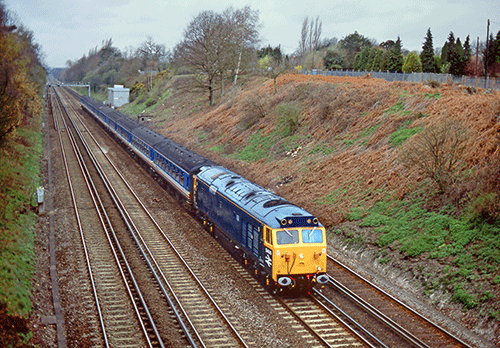
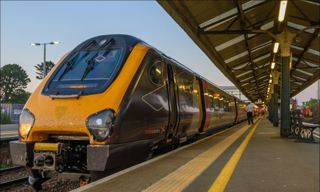
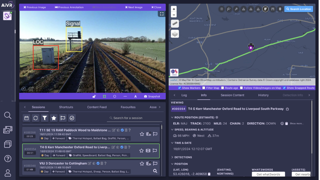
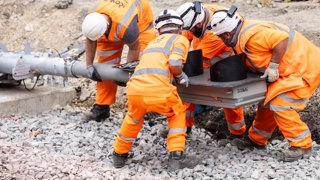
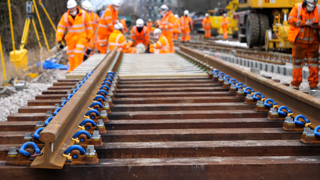










Trish Franks-volunteer at NYMR - 08/03/2023 17:53
Saw the Fearless in York station a few weeks ago.It looked really special and I now know a lot about it.